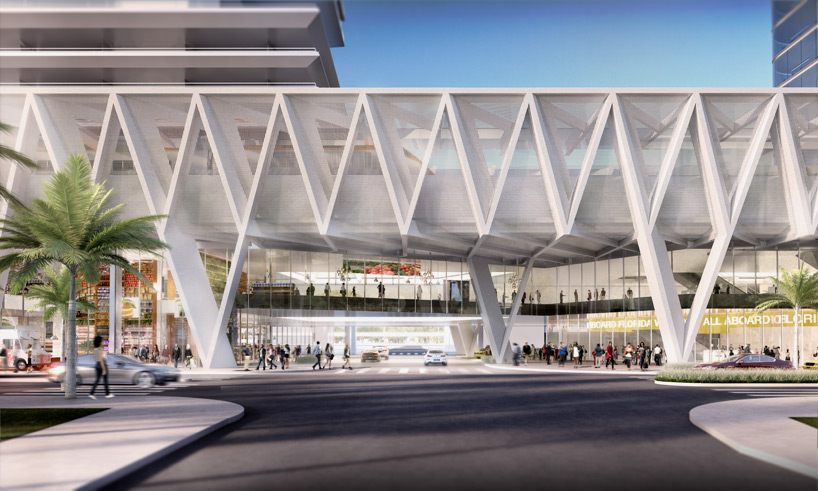As a part of the overarching project All Aboard Florida, Skidmore, Owings, and Merrill has designed a multimodal transit hub for Miami, one of three that will eventually connect Miami to Orlando by train.
The station will serve an estimated 12 million Floridians each year, and is meant to eliminate at least three million car trips each year.
The main terminal is located about 50 feet above street level. The space below will be full of retail spaces; the elevated terminal will allow for all roadside properties to remain leaseable, according to designboom.
“This project is a true celebration of the power and potential of transit-oriented development,” Roger Duffy, Design Partner at SOM, said in a press release. “We are excited to continue working with All Aboard Florida to realize this vibrant infrastructural undertaking, unparalleled in its scope, scale, and vision.”
Passenger service is expected to begin in 2016.
Here is SOM's full press release on the project:
In a ceremony today, Miami Mayor Tomás Pedro Regalado, Miami-Dade County Mayor Carlos A. Gimenez, and All Aboard Florida executives unveiled designs for All Aboard Florida’s new multimodal hub for Miami, planned and designed by Skidmore, Owings & Merrill LLP (SOM). In addition to the Miami hub, SOM is also planning and designing All Aboard Florida’s passenger stations in Fort Lauderdale and West Palm Beach, which will be unveiled at a later date.
All Aboard Florida is the only privately owned, operated and financed project of its kind being developed in the United States today. All Aboard Florida’s 235-mile network of rail lines will connect South Florida to Orlando by utilizing the current rail infrastructure for the Florida East Coast Corridor between Miami and the Space Coast and creating new tracks into Central Florida. The transformational infrastructure project will provide a vital new service for Florida residents, business people, and visitors and eliminate more than three million car trips from the region’s roadways each year. Passenger service is anticipated to begin in late 2016.
“An estimated 12 million travelers will benefit from the Miami station,” says Michael Reininger, President and Chief Development Officer, All Aboard Florida. “All Aboard Florida provides a fast and convenient transit alternative for this growing demand and need, while integrating transportation infrastructure with mixed use development to serve as a catalyst for transformation and economic vitality in a city that is quickly becoming a model for urban living today.”
“This project is a true celebration of the power and potential of transit-oriented development,” states Roger Duffy, Design Partner at SOM. “We are excited to continue working with All Aboard Florida to realize this vibrant infrastructural undertaking, unparalleled in its scope, scale, and vision.” Florida?based Zyscovich Architects is serving as the project’s Associate Architect and Planner.

renderings courtesy SOM / © SOM
SOM’s three stations will be key portals within All Aboard Florida’s rail system. Envisioned not only as gateways to their respective cities, but also as iconic destinations, the terminals will be filled with spaces to shop, eat, and meet. In downtown Miami, SOM has responded to an extraordinarily challenging and dense site by elevating the railways 50 feet in the air. Retail spaces are vertically layered beneath the soaring tracks and ample use of glass will give the station a shimmering, lightweight quality. This innovative solution allows thru-streets to remain open to traffic and for valuable streetfront real estate to remain leasable. Moreover, this bold architectural gesture creates a landmark terminal—a symbol of a 21st-century Miami.
As pieces of urban infrastructure, the stations are positioned to become centers of gravity for significant urban redevelopment. Economists estimate that All Aboard Florida will pump more than $6 billion into the Florida economy over the next eight years.
“Florida is poised to become the third largest state in the nation due to population growth,” said Kristopher Takacs, SOM Project Manager. “All Aboard Florida responds to this swelling demand by providing a fast and convenient transit alternative to the state’s highways and airport terminals. By integrating this transportation infrastructure with future mixed-use development, the terminals will be the catalysts to transform these cities locally, regionally, and globally.”
SOM has more than seven decades of experience in planning, designing, and implementing large?scale city-building projects that combine transportation infrastructure with urban mixed-use development. In the past twenty years alone, SOM has completed more than $5 billion dollars worth of transportation construction projects around the world, including complex intermodal and multimodal facilities, subway and rail stations, ferry terminals, the design of entire airports and more than a dozen airport terminals.

renderings courtesy SOM / © SOM
All Aboard Florida is an intercity passenger rail project being developed by Florida East Coast Industries, Inc. (FECI) — owner of Florida’s premier passenger rail corridor — that will connect Miami to Orlando with intermediate stations in Fort Lauderdale and West Palm Beach. This rail service will give Floridians and visitors a viable transportation alternative to congested highways and airport terminals. All Aboard Florida will provide a high?quality experience for passengers and will be the first privately owned, operated, and maintained passenger rail system in the United States. For more information, visit www.AllAboardFlorida.com.
About Florida East Coast Industries, Inc.
Florida East Coast Industries, Inc. (FECI), through its subsidiaries and affiliates, is one of Florida’s oldest and largest integrated, full?service real estate and infrastructure companies. Headquartered in Coral Gables, FL, FECI has a rich history dating back over a century when Henry Flagler first established the company which became a pioneer in the development of Florida’s eastern coast.
About Zyscovich Architects
Zyscovich Architects (Zyscovich) is an international master planning, architecture, and interior design firm with offices in Miami, West Palm Beach, Orlando, New York City, Bogotá, and Tobago. The firm's innovative approach to planning, Real Urbanism™, embraces the history and economics of a community to create a unique vision that brings tangible value and improved quality of life to the area. The firm's commitment to customized solutions is also evident in its award winning architectural design work for both public and private clients. Zyscovich's broad range of experience includes large?scale mixed?use, transportation, educational, commercial, retail, multi?family residential, and hospitality projects.
About Skidmore, Owings & Merrill LLP
Skidmore, Owings & Merrill LLP (SOM) is one of the leading architecture, interior design, engineering, and urban?planning firms in the world, with a 75?year reputation for design excellence and a portfolio that includes some of the most important architectural accomplishments of the 20th and 21st centuries. Since its inception, SOM has been a leader in the research and development of specialized technologies, new processes and innovative ideas, many of which have had a palpable and lasting impact on the design profession and the physical environment. The firm’s longstanding leadership in design and building technology has been honored with more than 1,700 awards for quality, innovation, and management. The American Institute of Architects has recognized SOM twice with its highest honor, the Architecture Firm Award—in 1962 and again in 1996. The firm maintains offices in New York, Chicago, San Francisco, Los Angeles, Washington, D.C., London, Hong Kong, Shanghai, Mumbai and Abu Dhabi.
Related Stories
Building Technology | Jun 18, 2024
Could ‘smart’ building facades heat and cool buildings?
A promising research project looks at the possibilities for thermoelectric systems to thermally condition buildings, writes Mahsa Farid Mohajer, Sustainable Building Analyst with Stantec.
University Buildings | Jun 18, 2024
UC Riverside’s new School of Medicine building supports team-based learning, showcases passive design strategies
The University of California, Riverside, School of Medicine has opened the 94,576-sf, five-floor Education Building II (EDII). Created by the design-build team of CO Architects and Hensel Phelps, the medical school’s new home supports team-based student learning, offers social spaces, and provides departmental offices for faculty and staff.
Healthcare Facilities | Jun 18, 2024
A healthcare simulation technology consultant can save time, money, and headaches
As the demand for skilled healthcare professionals continues to rise, healthcare simulation is playing an increasingly vital role in the skill development, compliance, and continuing education of the clinical workforce.
Mass Timber | Jun 17, 2024
British Columbia hospital features mass timber community hall
The Cowichan District Hospital Replacement Project in Duncan, British Columbia, features an expansive community hall featuring mass timber construction. The hall, designed to promote social interaction and connection to give patients, families, and staff a warm and welcoming environment, connects a Diagnostic and Treatment (“D&T”) Block and Inpatient Tower.
Concrete Technology | Jun 17, 2024
MIT researchers are working on a way to use concrete as an electric battery
Researchers at MIT have developed a concrete mixture that can store electrical energy. The researchers say the mixture of water, cement, and carbon black could be used for building foundations and street paving.
Codes and Standards | Jun 17, 2024
Federal government releases national definition of a zero emissions building
The U.S. Department of Energy has released a new national definition of a zero emissions building. The definition is intended to provide industry guidance to support new and existing commercial and residential buildings to move towards zero emissions across the entire building sector, DOE says.
Multifamily Housing | Jun 14, 2024
AEC inspections are the key to financially viable office to residential adaptive reuse projects
About a year ago our industry was abuzz with an idea that seemed like a one-shot miracle cure for both the shockingly high rate of office vacancies and the worsening housing shortage. The seemingly simple idea of converting empty office buildings to multifamily residential seemed like an easy and elegant solution. However, in the intervening months we’ve seen only a handful of these conversions, despite near universal enthusiasm for the concept.
Healthcare Facilities | Jun 13, 2024
Top 10 trends in the hospital facilities market
BD+C evaluated more than a dozen of the nation's most prominent hospital construction projects to identify trends that are driving hospital design and construction in the $67 billion healthcare sector. Here’s what we found.
Adaptive Reuse | Jun 13, 2024
4 ways to transform old buildings into modern assets
As cities grow, their office inventories remain largely stagnant. Yet despite changes to the market—including the impact of hybrid work—opportunities still exist. Enter: “Midlife Metamorphosis.”
Affordable Housing | Jun 12, 2024
Studio Libeskind designs 190 affordable housing apartments for seniors
In Brooklyn, New York, the recently opened Atrium at Sumner offers 132,418 sf of affordable housing for seniors. The $132 million project includes 190 apartments—132 of them available to senior households earning below or at 50% of the area median income and 57 units available to formerly homeless seniors.


















